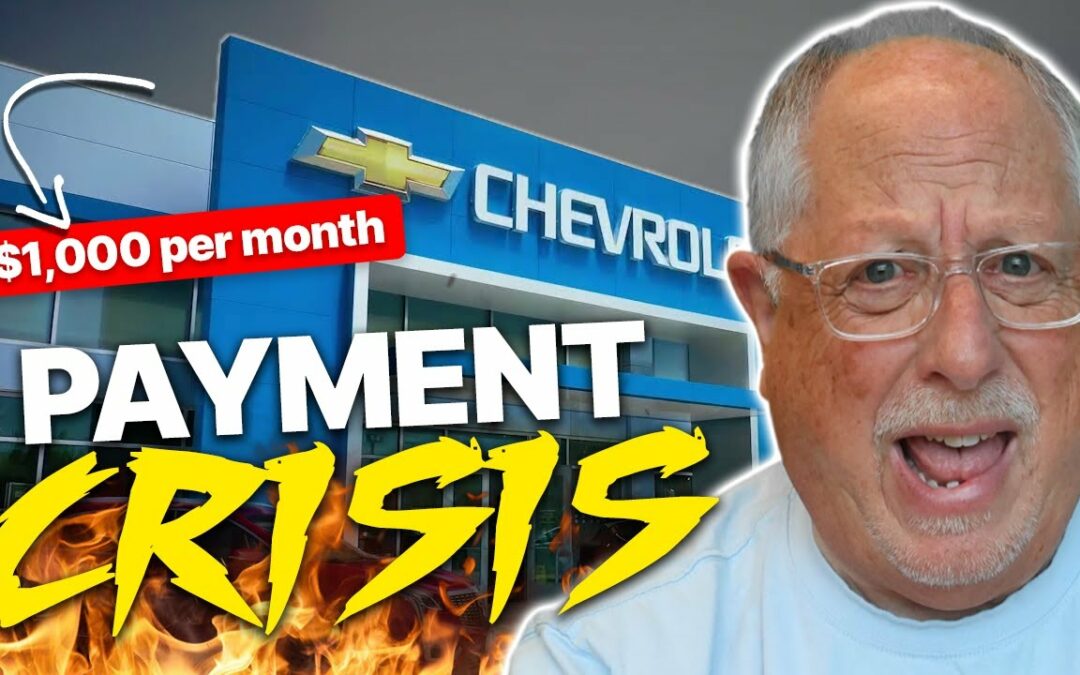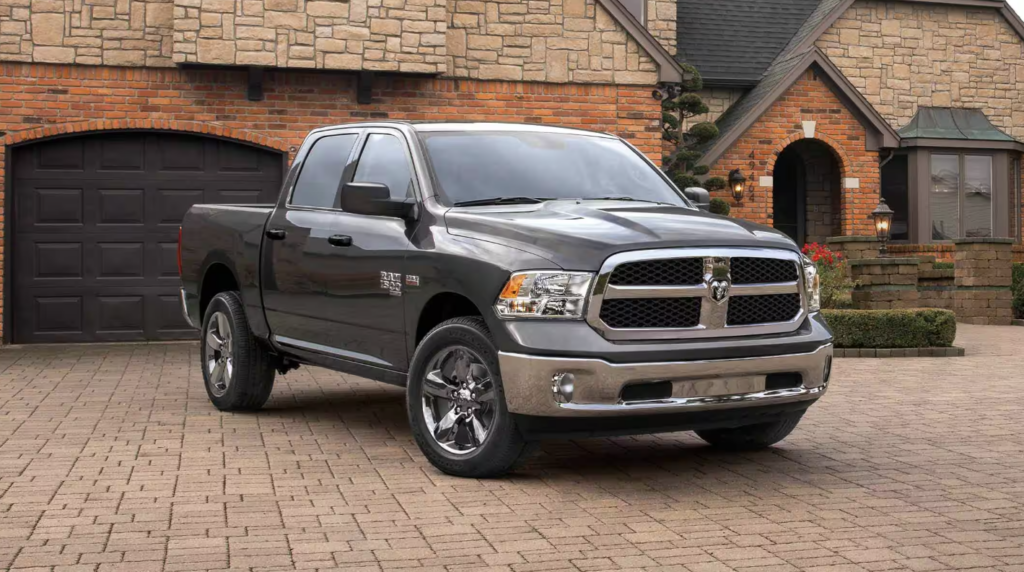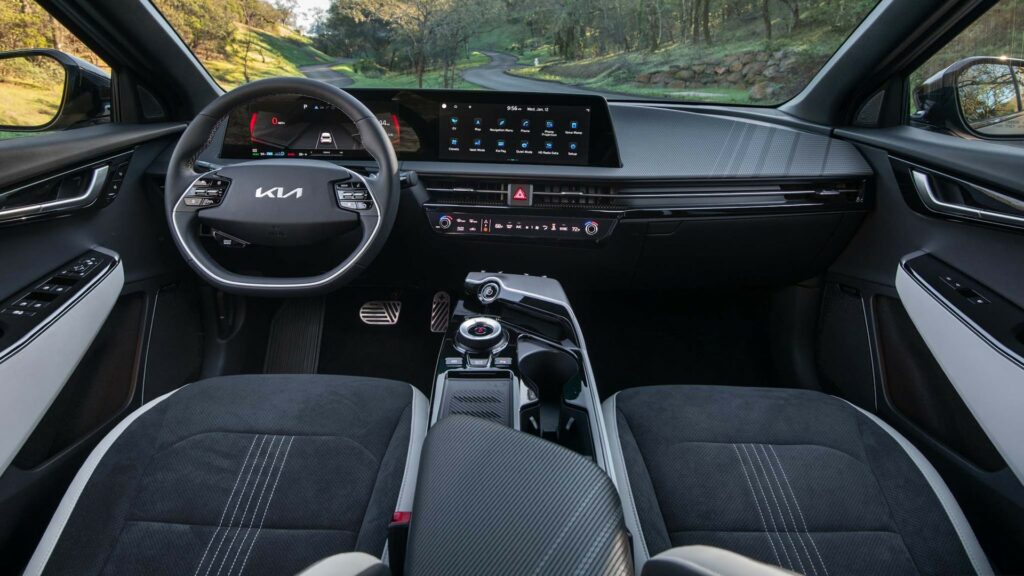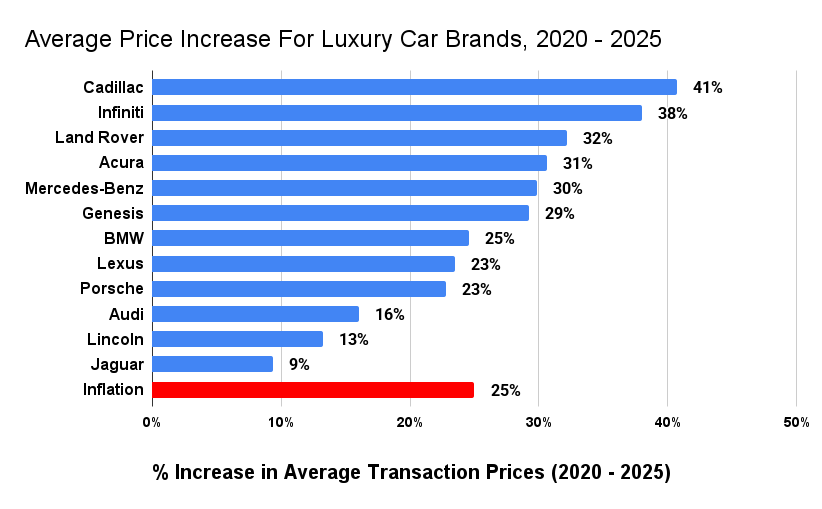CarEdge saved me over 4,500 dollars on a brand new Honda Pilot. I can't say thank you enough.
Price intelligence
Find a wide range of vehicle listings with market insights on new and used listings near you.


Help us personalize your CarEdge experience — it only takes a second.
Your answers help us personalize your CarEdge journey — we’ll follow up with tips and next steps that match your buying timeline.

Right now, there’s a 41-day supply of new Toyota vehicles in the U.S. What this means is, at the current sales pace, all 261,604 new Toyotas would find their new homes in just over a month without new inventory. But how does this scenario compare to other auto manufacturers? And more importantly, which Toyotas give you the most room for negotiation, and which ones are holding their ground? Let’s dive into the details.
| Make | Inventory % Increase (3 Months) | Market Day Supply - December 2023 | Market Day Supply - September 2023 |
|---|---|---|---|
| Honda | +68% | 47 | 28 |
| Kia | +89% | 53 | 28 |
| Toyota | +37% | 41 | 30 |
| Hyundai | +50% | 75 | 50 |
| Chevrolet | +63% | 88 | 54 |
| Nissan | +58% | 112 | 71 |
| Volkswagen | +52% | 96 | 63 |
| Ford | +43% | 127 | 89 |
| Jeep | +31% | 191 | 146 |
Market Day Supply (MDS) is a leading industry metric that is used to assess inventory. Market day supply takes the average daily sellin rate and existing inventory into account to determine how long it would take to sell every vehicle in inventory at recent average selling rates. A healthy ‘normal’ MDS is anywhere between 45 and 65 days of supply.
As you can see, Toyota has the lowest new car inventory among mainstream brands in America with just 41 days of supply. Honda, long perceived as Toyota’s most direct competitor, is #2, but is faring better at 47 days of supply. Kia comes in third with 53 days of inventory.
Contrarily, Nissan, whose market share has been dwindling in the U.S., unsurprisingly has an oversupply of new car inventory at the moment with a MDS of 112 days. Nissan was hit hard by the chip shortage, but the brand doesn’t seem to be winning back many of the customers it lost. Nissan’s US market share is now at just 4.9%.
And then we have the American automakers. Chevrolet is above average with a 88-day supply, but Ford and Jeep are drastically exceeding healthy inventory levels. Jeep is in the lead, with 191 days of supply. Although this isn’t the best news for these automakers, it certainly opens up opportunities for car buyers looking to drive a hard bargain.

If your goal is to save thousands of dollars on your new Toyota, then it’s time to talk about negotiability at a finer scale. For that, we need to look at today’s inventory numbers across the Toyota model lineup.
Using the tools available through CarEdge Data, we analyzed Toyota inventory for every model on sale in America. These numbers reflect nationwide supply. You can check out local Toyota inventory using CarEdge Data.
| Make | Model | Market Day Supply (October) | Market Day Supply (September) |
|---|---|---|---|
| Toyota | Venza | 46 | 39 |
| Toyota | 4Runner | 61 | 45 |
| Toyota | Tundra | 63 | 34 |
| Toyota | Crown | 88 | 57 |
| Toyota | bZ4X | 110 | 94 |
Remember, a healthy auto market is characterized by about 60 day’s supply of new vehicles. The further inventory gets away from that, the more ‘out-of-whack’ the car market becomes. These models have the most inventory today of all Toyota models.
The redesigned Prius was on this list last month with a 73-day supply, but now the Prius seems to be selling quickly.
The Grand Highlander has been selling a lot quicker, and is going to be a lot tougher to negotiate now. Toyota’s new darling, the resurrected Crown, is selling slowly. Perhaps car buyers don’t have the appetite for $50,000 sedans that Toyota had expected.
The bZ4X electric SUV tops the list, with 110 day’s supply. With no federal tax credit and similarly priced, better equipped competitors, we’re not surprised.
Don’t negotiate without this FREE cheat sheet!
| Make | Model | Market Day Supply (October) | Market Day Supply (September) |
|---|---|---|---|
| Toyota | Camry | 39 | 30 |
| Toyota | Grand Highlander | 20 | 20 |
| Toyota | Highlander | 36 | 32 |
| Toyota | Sienna | 30 | 25 |
| Toyota | Corolla Cross | 28 | 27 |
| Toyota | RAV4 | 32 | 28 |
| Toyota | Sequoia | 44 | 23 |
| Toyota | Tacoma | 42 | 32 |
| Toyota | Corolla | 41 | 18 |
The Camry is the best-selling sedan in America, and Toyota can’t seem to produce enough of them. There’s a 39-day supply of them, and in some local markets, the situation is even worse. Despite slim supply, our Car Coaches say you should NOT pay dealer markups for the Camry, or any model for that matter. The Highlander is not much better, with a three-week supply nationwide.
Our CarEdge Coaches joke that the RAV4 Prime is their nemesis. It’s very tough to negotiate, all because of extremely limited inventory. Across all powertrains, the RAV4 has just a one-month supply right now.
See Toyota listings near you – all with the power of local market data.

Despite the slim pickings with some Toyota models, it’s still possible to negotiate some great deals. Even for models in highest demand, there’s no reason you should have to pay for dealer markups, forced add-ons, or overpriced warranties.
Ready to negotiate like a pro? Try CarEdge Coach and CarEdge Data today! With these tools at your disposal, you can take control of your car buying experience, understand market dynamics, strategize effectively, and secure the best deal possible. We’re simply here to help!

The average car payment has been on an upward trajectory for some time, and 2023 is no exception. Today, we’re dissecting what the average car payment looks like and why it’s been rising. We’ll explore how average monthly car payments crossed the $1,000 threshold, and how you can navigate this landscape to spend less.
| (New Cars) | 2023 Q3 | 2023 Q2 | 2023 Q1 |
| Average Term | 68.4 | 68.5 | 68.8 |
| Monthly Payment | $736 | $733 | $730 |
| Amount Financed | $40,149 | $40,356 | $40,468 |
| Average APR | 7.4% | 7.1% | 7.0% |
| Down Payment | $6,907 | $6,823 | $6,956 |
According to Edmunds’ latest data, the share of $1,000+ monthly car payments has hit an all-time high. The rise is attributed to various factors: high interest rates, increased automaker prices, and dealer practices.
Reaching a new record, 17.5% of new car loans in Q3 2023 required a monthly payment of $1,000 or more. That’s up from 17.1% in Q2 2023 and a massive increase from the meager 4.3% back in 2019.
The average car payment in Q3 2023 reached a record high of $736 per month for new cars, up 4.5% since Q3 2022, and a 32% increase from 2019. Meanwhile, the average monthly car payment for used cars is $567, marking a 46% rise from 2019, but up less than 1% from Q3 2022.
Take a look a the average new car payment over time:

Data source: Edmunds. Graph by CarEdge.
The average monthly payment for used cars has followed a similar path upward, as we can see here:

Data source: Edmunds. Graph by CarEdge.
In pre-pandemic times, there was a slow but steady rise in car payment amounts. As the auto industry came out of the pandemic recession and the following chip shortage, car prices went through the roof, bringing average monthly payments along with them.
Let’s talk about why car payments are so high right now, and what you can do about it.
So, how much have car prices gone up? The average transaction price for a new car is $48,451 in 2023, a 25% increase since 2019. For used cars, it stands at $28,381, still 37% higher than in 2019, despite a slight decrease from the previous year. To make matters worse, interest rates for used car loans are commonly over 10% these days.
We track used car prices weekly. See the latest data!
Why are average monthly car payments and overall prices rising so fast? The auto industry can’t simply blame it on inflation, as we’ll get into below. But first, let’s talk about financing.
Car buyers are making larger down payments as the cost of borrowing money increases. The average auto loan rate is now 7.4% APR for a new car loan, and 11.2% APR for a used car loan. These are the highest auto loan rates the market has seen since 2007.
When will car loan rates go down? Simply put, it’s up to the Fed. The Federal Reserve sets the ‘Federal Funds Rate’, which largely determines how much it costs for banks to borrow money from each other, ultimately driving consumer loan rates.
Raising interest rates is a tool used to combat inflation. The thinking goes that when borrowing gets too expensive, excessive spending will be discouraged, and in turn demand for goods and services will cool down to the point that inflation slows.
Car loan rates will remain high until The Federal Reserve begins to lower interest rates at their Board meetings. Inflation needs to cool down for that to happen. Things are headed in the right direction, but we’re not there yet.

FREE Resource: How to Finance a Car Like a Pro: The Ultimate Auto Financing Cheat Sheet
Even with auto loan rates at 20-year highs, there ARE ways you can lock in big savings on loan interest. Here are the most effective ways to save on interest, according to our CarEdge team of experts:
Check out our deep dive into the many ways you can spend less on auto loan interest. With today’s interest rates, these tips could save you hundreds of dollars! Don’t forget to print this auto finance cheat sheet and bring it with you!
Our team of Car Coaches is made up of professionals who have decades of experience in the auto industry. Rather than squeeze more money out of every sale at the dealership, these car pros help drivers SAVE money with their auto. We spoke to our team of Coaches to learn how much money today’s car buyers should aim to spend on their monthly car payment.
The consensus was broad: the CarEdge team advises keeping your monthly car payment below 10% of your monthly take-home pay. With gas, insurance, and maintenance, it should ideally be well below 20% of your monthly income. It’s worth noting that negotiation can play a pivotal role in ensuring you spend less on your car.
Here are a few essential FREE resources to help you budget for your car purchase:
Browse cars with expert help just a click away with CarEdge Car search.
Use this Free Out-the-Door Price Calculator to more accurately estimate how much your car will cost once taxes and fees are included.
Here’s a Free Car Payment Calculator that will help you understand what price range you can afford with your down payment. It’s most useful if you have an idea of what loan rates you might qualify for.

Most automakers have an oversupply of new cars right now. Over the past year, we’ve seen dealer lot inventory climb above and beyond what we typically see in a healthy, stable car market. Automakers and dealers like to have roughly a 60 day supply of new cars on their lots. Today, we see more and more models well above a 100 day supply. For some, like the Ford Mustang Mach-E, Jeep Renegade and Ram 1500 truck, inventory exceeds 200 days.
Something has to give. Floorplanning costs mean that the car dealers themselves pay interest for every day that a car sits on their lot. Plus, no one wants a two-year old ‘new’ car. With each passing day, dealers are incentivized to move their inventory off the lot.
We’re seeing used car prices fall rather quickly, yet new car prices are more complicated. Listing prices remain high (and in some cases outrageous), but our team of CarEdge Coaches is seeing greater negotiability on the new car market.
Dealers are more willing to lower their prices and remove add-ons and markups. However, in most cases, this is only true when the buyer is prepared to put some work into the deal with negotiation know-how. Don’t expect softball deals in today’s new car market. But don’t fret: we’re here to help.
Our team of Car Coaches created this 100% free guide to negotiating a car purchase with one goal: to save you time and money. Print it and bring it with you to the dealership!
Negotiate Car Prices With This Cheat Sheet
Looking for more car buying help? Search our free guides, and join the CarEdge Community today! We’re here to help you negotiate car prices confidently. When it comes to car buying, knowledge certainly is power.
Ready to work 1:1 with your own car buying coach? Learn more about CarEdge Coach, your path to ultimate savings! Looking for more of a DIY route to savings? We created CarEdge Data just for you. For the first time ever, behind-the-scenes market data is at your fingertips, empowering car buyers everywhere to negotiate with confidence.
Remember, the secret to smart car buying isn’t solely about discovering the car that captures your heart. It also involves understanding the market you’re shopping in. Despite escalating prices, opportunities remain for those willing to undertake comprehensive research and exhibit patience.
Stay informed, be patient, and you might find that the perfect deal is just a stone’s throw away. We’re here to help!

Ever wondered why the allure of an affordable new truck seems more like a mirage these days? Despite the lot inventories of best-sellers skyrocketing far beyond the norms of a healthy market, securing an affordably priced new truck has become tougher than ever.
So, what’s behind this paradox? The answer lies in the automakers’ strategic drift from the production of affordable base models. But, is this strategy set to steer the truck industry into troubled waters? Let’s uncover the truth using CarEdge and MarketCheck’s latest data on the state of the truck market in 2023.
There’s an interesting trend that the top-selling trucks in America all share: as the total production figures rebounded from pandemic lows, the production of affordable base models hasn’t kept pace. The strategic move by automakers to limit the production of entry-level models has created scarcity, contributing to their increased prices.

Focusing on one of the best-selling trucks in America, the Ram 1500, CarEdge Data reveals that there are 53,652 new Ram 1500s on sale across the nation. However, the most affordable trim option, the Ram 1500 Tradesman, only makes up a mere 3,445 of this total. Despite having a starting price of just $37,090, the Tradesman, as a result, seems like a near-mythical entity in dealer lots.
The scarcity of base model Ram 1500s isn’t the only issue; the prices of these scarce models have surged as the supply diminished. The Ram 1500 Classic witnessed a 26% price hike from 2019 to 2023, while its inventory dropped by a whopping 88%.
Sadly, the trend isn’t exclusive to Stellantis. Both the F-150 XL and the Chevrolet Silverado Work Truck have also followed the same downward trajectory in their base models’ production:

The Silverado 1500 Work Truck experienced a 41% price increase since 2019, even though its inventory has decreased by 33% over the same period. Today, the base model Work Truck represents a meager 6% of the 67,795 brand-new Silverados available on the market.
Despite the combined U.S. sales of America’s three top-selling trucks rising by 2.5% from the pre-pandemic norms of Q1 2020, the inventory of base models like the F-150 XL sits at just 54% of the pre-pandemic levels.
Here’s a look at how overall truck sales (across all trims) has risen back from pandemic lows, despite leaving affordable base trims behind:

Similarly, the Silverado Work Truck is at a mere 49% of early 2020’s inventory. The worst hit is the Ram 1500 Classic, languishing at 23% of January 2020’s inventory, notwithstanding the overall Ram 1500 sales recovering to 91% of the pre-pandemic levels.
The picture is clear: truck inventories have fully recovered from the inventory woes of 2021, but affordable base models were largely left out of the picture. The result: truck buyers are pushed towards more expensive truck options, feeding into the ultimate goal of the automakers – ever higher profits.

From skyrocketing destination charges to the elimination of popular base models, it’s apparent that automakers are leaving no stone unturned in their bid to maximize profits from each sale. However, this aggressive strategy has not been left unchecked. Consumers are pushing back, sparking significant changes in the industry. A classic example is Honda, which, within a year of canceling the base LX trim for the CR-V and Civic, reversed their decision due to consumer pressure. Kia, too, had to reintroduce its most affordable EV6 after initially discontinuing it.
Car buyers push back, forcing the return of base models
The real question now is, will truck lovers follow suit and make their voices heard? And more importantly, will the major automakers – Ford, GM, and Stellantis – heed the call, or continue their current strategy, potentially alienating millions of middle-class loyal customers?
Don’t let the ever-changing trends in the auto market throw you off guard. Navigate the landscape like a pro with CarEdge Data and get the latest industry insights at your fingertips. Ready for 1:1 help with your deal? With CarEdge Coach, our Car Coaches are at your side via live chat every step of the way, ensuring you find the perfect vehicle at an unbeatable price.
Already found the truck of your dreams? Get comprehensive market price data for every new or used truck listing with CarEdge Reports, included with our Data and Coach plans. Let CarEdge steer you towards your perfect ride. We’re here to help!

As 2023 model year lineups were announced last year, a sizable portion of the automotive industry faced widespread criticism for eliminating their most affordable vehicles from the lineup. At a time when new car prices were running away from the middle class, the most affordable versions of popular cars were sacked.
Now, in 2024, car manufacturers are reversing course. Are we about to see the resurrection of affordable cars? Or are we getting our hopes up too soon? Let’s take a look at where we’ve been, where things stand today, and where we’re headed as new car sales continue through yet another volatile year.
You could say Tesla started it all when they axed the much-hyped $35,000 version of the Model 3 years ago. However, legacy automakers are a different animal entirely, so we’ll fast forward to 2022. Late last year, Honda led the charge with changes to their product lineup, and were soon followed by Kia and Jeep. Within months, multiple base models were discontinued in the United States, sending entry-level prices through the roof overnight for some of the most popular cars in America.
This was no small move. Together, these manufacturers account for 30% of new car sales in the U.S. The effects were swift and significant, leading to an outcry among car buyers, and as one Kia representative put it, ‘unprecedented demand’ for what had previously been seen as unwanted, unpopular base trims.
Automakers cited lower sales numbers and the supply chain woes of 2021-2022 when explaining the abrupt decision. However, in doing so, they overlooked the crucial role these base models play in catering to the needs of lower-income and budget-conscious drivers. Without affordable base models, a large chunk of the market would be priced out, and would simply take their business to used car lots.
Fast forward to 2024, and some of these same automakers are now making a U-turn, resurrecting their affordable vehicles. The most shocking reversal comes from none other than…. Honda.

Honda ruffled feathers when it eliminated the most affordable Honda Civic, the LX base model, in late 2022. This decision followed an earlier price hike between $1,000 – $2,000 for the 2023 model year. Consequently, budget-conscious commuters, the heart of Honda’s fanbase, were left reeling just as interest rates climbed higher. Further compounding the issue, the CR-V, America’s #2 best-selling SUV, also lost its base trim.
As the base trims were dropped, the entry-level price for the Civic increased from $22,350 to just north of $25,000 for the EX. For the CR-V, the base price jumped by almost $5,000 overnight to $31,610.
The rationale behind these decisions might have been an attempt to boost profits amidst supply chain issues that had plagued Honda since 2021. However, by mid-2022, the automaker’s US sales had plummeted 50% year-over-year.
Now, Honda seems to be having a change of heart. In response to decreasing new car prices and slowed sales, the company has announced the return of the more affordable CR-V in 2024. The CR-V LX, without a sunroof, power-adjustable driver’s seat, and with just a single climate control zone, now lists for $28,410 plus a $1,295 destination fee.

Around the same time as Honda’s controversial move, Kia also announced the cancellation of the most affordable version of its popular electric car, the Kia EV6. This caused the base price of the EV6 to soar by $7,300, or 18%, to nearly $49,000. Furthermore, the beloved gas-powered Kia K5 also lost its LX base trim, pushing the entry price to $26,195.
Kia, once known for affordability, seemed to be pushing further into premium territory.
However, 2023 and 2024 have seen Kia backtrack somewhat, albeit with certain conditions. The automaker is now offering the EV6 Light in select western US states. The EV6 Light has even returned to Kia’s online configurator.
We call this a win for consumers, especially considering that Kia’s EVs lost the federal EV tax credit this year due to the Made in (North) America requirement.
As far as the Kia K5, the entry-level LX trim has yet to return. The K5 now starts at $26,515 with destination fees. For reference, the 2019 Kia Optima started at $23,915, or 11 percent less than today’s K5.
There’s a 399 day supply of Jeep Renegades nationwide, according to the car buying tools available through CarEdge Pro. This didn’t happen overnight. Jeep’s inventory has been building for months. In fact, every Jeep model has over 100 day’s supply, far above the industry’s healthy standard of 60 days.
You would have thought that Jeep’s parent company Stellantis would have seen the writing on the wall, and perhaps even would have considered lowering prices or introducing incentives.
What we got was the complete opposite. The boxy, poor-selling and unreliable Jeep Renegade lost its Sport base trim for the 2023 and 2024 model years. What happened next? Jeep’s inventory just kept on climbing, and now leads the industry for number of cars on the lot.
Here’s a full breakdown of Jeep inventory today, and where the best deals could be negotiated.
In the past five years, new car prices have risen by a staggering 37%. However, there seems to be a light at the end of the tunnel. Our own analysis reveals that automakers who have hiked prices the most are paying the price in the form of WAY too much inventory. See for yourself in the graph below showing how much inventory is on the lot for top-selling models that received price hikes this year.

Buyers are pushing back against runaway new car prices. Dealers are loaded with inventory that won’t sell. See which automakers are suffering the consequences right now, and how YOU can use this as negotiation leverage.
When it comes to the car market, we’re no stranger to the ups and downs. Get ready for yet another market adjustment, according to at least one group of experts.
A report by industry analysts at AlixPartners forecasts a steady decline in new car transaction prices over the next few years.
By 2025, the analysts expect the average transaction price to decline to around $42,000, down from where it stands today near $46,000.
What do they expect to drive this downward trend in prices? The dynamics don’t “mean the price of the same vehicle comes down,” Mark Wakefield, global co-leader of the automotive & industrial practice at AlixPartners, said at a press conference. “The predominant driver of that is mix shift and trim shift within a product to reduce the higher, more profitable vehicles and get more volume out.”
In other words, it looks like automakers are coming to their senses (at least somewhat) and are planning to make higher numbers of lower-trim vehicles at more accessible price points.
What if there was a way to guarantee you never overpay for a car again? We’re here to make that a reality for you. Don’t let the journey to your dream car be a bumpy one. Our CarEdge Coaches are ready to guide you every step of the way, ensuring you find the perfect vehicle at an unbeatable price.
Or, if you’re a do-it-yourself enthusiast, use CarEdge Pro to get the industry insights you need to negotiate like a pro.
Let CarEdge steer you towards your perfect ride. We’re here to help!
![Car Price Inflation Is Real – These Brands Are the Worst [2025 Update]](https://caredge.com/wp-content/uploads/2023/07/2024-08-22_Big-Data-Update_-Car-Price-Inflation_Blog-Header-Image_1920x1080_v1-1080x675.jpg)
This decade has brought a whirlwind of challenges for the automotive industry. From pandemic shortages and EV investments to today’s inflation and tariff pressures, lack of stability would be an understatement. So, how have car prices fared over the last five years? Across the new car market, average transaction prices have increased by 30% from Q2 2020 to Q2 2025. The average selling price for a new car now stands at $48,749.
But some automakers seem to have thrown caution to the wind, pushing their prices far higher. Here’s a look at car price inflation over the last five years.

Leading the pack in price hikes is Volkswagen Group, which includes VW, Audi, Porsche, Bentley, and Lamborghini in the United States. The average transaction price for Volkswagen Group has increased by 38% from Q2 2020 to Q2 2025, which is quite a bit higher than the overall economy’s inflation (25%) over the same period.
Hyundai Group (which includes Kia) and Honda are close behind. Hyundai Group prices are up 34% in the first half of this decade. EVs like the new IONIQ 9 are a big reason for the price hike. Honda prices increased by 33% from 2020 to 2025 as MSRPs increased and buyers showed increasing preference for larger SUVs. Honda’s best-seller, the CR-V crossover, saw base MSRPs jump from $26,345 in 2019 to $31,495 in 2025.
General Motors is next in line, with prices up 30% since 2020. Chevrolet and Cadillac prices have risen as EVs have populated the lineup, and trucks like the Silverado 1500 get ever more expensive. In 2020, the Chevy Silverado 1500 RST started at $38,695. For 2025, that same spec of the Silverado starts at $52,345.

However, there’s a bright spot in the data. Ford, Stellantis, Nissan, and Subaru price increases were below the overall rate of inflation over the past five years. Data was unavailable for Mazda.
Subaru seems to have taken a different strategy with a five-year transaction price increase of only 15%, well below the pace of overall inflation. Subaru has managed to maintain an upward trajectory in terms of market share. This gain, paired with standard offerings like all-wheel drive, could be a testament to the importance of price competitiveness in the industry.
Nissan, on the other hand, has likely seen less price increases for a different reason. Nissan has been losing U.S. market share for years as Toyota, Honda, Hyundai, and Kia win over budget shoppers. When demand falls, dealer markups and MSRPs soften. Since 2019, Nissan transaction prices have risen 14%. And now, two of Nissan’s most popular and affordable models, the Altima and Versa, are being discontinued next year.
To the detriment of vehicle affordability, luxury cars are more popular than ever. More drivers are paying over $80,000 for a new car or truck than ever before. Oddly enough, luxury car prices haven’t climbed quite as much over the past half-decade. While mainstream car brands saw prices climb 30%, luxury brands increased by 25% from 2020 to 2025.
Here’s a look price inflation for some of the best-selling luxury brands in America compare. Note that Tesla is not included due to lack of publicly-available data from 2020.

Prices for new Cadillac, Infiniti, Land Rover, Acura, and Mercedes-Benz cars have all had average selling prices rise more drastically than their luxury competitors. All of these luxury cars now sell for at least 30% more than the did just five years prior.
On the other hamd, the luxury car brands with the lowest price increases are Jaguar, Lincoln, and Audi. Audi’s sales have slipped as the brand’s EVs fail to keep up with the competition in the crowded luxury crossover segment.
It’s true that new cars are a lot more expensive these days, but that doesn’t mean you have to surrender and sign whatever the dealer offers. There are still practical ways to save, even in 2025. Here are a few smart car buying tips from CarEdge Co-Founders, father-and-son duo Zach and Ray Shefska:
Use Market Data, Not MSRP
Rely on real-time transaction and listing data (like CarEdge Pro) to understand what others are actually paying in your area.
Target the Slow Sellers
Focus on vehicles with high inventory and long time-on-lot. Dealers are more willing to negotiate on slow movers. We’ve got tools to help you find negotiable inventory.
Look for Dealer-Backed Incentives
Even when automaker incentives are weak, individual dealers may offer their own discounts, especially near end-of-month or quarterly sales targets.
Negotiate More Than Just Price
Push for better financing terms, trade-in value, or extras like extended warranties or free maintenance. Here’s our guide to what’s negotiable at the dealership.
Time Your Purchase Strategically
Shop at the end of the month, end of the quarter, or during seasonal clearance events (like model year transitions). There’s even a better time of the day to buy! Be sure to check out our free tips for timing your purchase right.
Use AI Tools to Level the Playing Field
AI can be terrifying, but it can also be extremely helpful. CarEdge’s AI Negotiator can take the pressure off and ensure you don’t overpay. How does CarEdge AI work? Tell us what car you want, and our AI Negotiator will contact dealers and negotiate pricing for you! It’s really, really cool.
Ready for some expert car buying help to ensure you pay a fair price? That’s why we created CarEdge, the ultimate car buyer’s advocate. Learn more about how our team of consumer advocates is ready to assist you with your deal at CarEdge.com.
In 2025, the car market is changing. For the first time in years, great deals can be won with negotiation know-how. Utilizing tools like CarEdge’s FREE Car Buyer’s Guide can give you a better idea of current inventory levels and help you determine where the best deals might be.

Ready to outsmart the dealerships? Download your 100% free car buying cheat sheets today. From negotiating a deal to leasing a car the smart way, it’s all available for instant download.